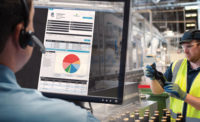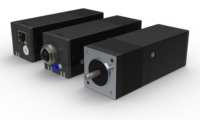Automation
Remote Service Keeps Productivity in Line
Accelerate production line recovery, while reducing lost time and money, with remote monitoring.




When any element on a production line fails, the entire production line probably goes down, at considerable loss of time and profit. The first thought of the maintenance engineer is, “How soon can I get it back up?” The pain begins when the line goes down and ends when the line recovers full production. A line recovery time of more than 30 to 45 minutes usually means that lost production will exceed the cost of changing out a down system such as a printer with a new unit.
For years, the solution was to call for the service technician, who was often located offsite, further extending downtime. Today, the addition of remote monitoring and service capability to line systems has accelerated the time of recovery, significantly reducing lost time and money by providing the immediate technical help that enables customers to either make repairs themselves or replace the unit in the shortest possible time. Remote service has also expanded the meaning of “service” to include predicting failure, avoiding unplanned shutdowns rather than recovering from them.
Inkjet printers, for example, mix ink with a solvent during printing to ensure that the ink flows smoothly and prints cleanly.
The solvent, a volatile chemical, can evaporate, causing an imbalance between the quantities of ink and solvent available. When this imbalance reaches a certain point, printing can continue, but print quality suffers and eventually the ink can become so thick that the printer will shut down.
Sensors within today’s printers monitor the solvent level and place an alert on the printer’s user interface screen when it drops below a certain point. If someone doesn’t respond to the alert, the system will send an email or text alert to the line supervisor, ensuring that the eventual shutdown and the associated lost productivity are avoided.
Remote service goes a step beyond this. While the equipment continuously gathers and stores status data that your operators can view, at certain moments you want to agree to give your supplier direct electronic access into the unit’s software controls. This enables the supplier’s service team to address issues for you — and allows you to teach your staff how to optimize your system to prevent or quickly solve future challenges — all without the team having to visit your facility. This results in prompt fixes, reduces unplanned downtime events and shortens those that occur. It also eliminates a significant number of service calls by enabling line personnel to correct a system problem before it becomes a failure requiring outside service.
Another aspect of remote service involves closer communication between the line operator and the supplier’s experts to troubleshoot a problem with equipment setup, typically during a product changeover on the line. The experts, by directly reaching into the equipment’s software, can quickly identify a faulty configuration setting or identify an onsite repair that can be made by the operator.
Such a partnership with the company that designed and made this equipment provides lone operators direct access to an expert when they need help. This allows operators to focus their attention on their primary responsibilities: line management, new product setup and changeovers.
Remote service is an especially valuable tool when equipment is operating in a harsh environment. Dusty, moist and extreme temperature conditions, or locations subject to strong vibration, mean that equipment will be unusually stressed and must be monitored more closely. Standard maintenance procedures may not be adequate. But remote monitoring — and alerting operators to new maintenance concerns — can increase your equipment’s productivity and extend its working life.
The Growth of Remote Service
Remote service, including monitoring, repairing and obtaining the data from equipment to manage both of those activities, has been growing steadily. For about the last four years, much of the equipment introduced into production lines has incorporated software with the capability to be accessed remotely in order to monitor performance, even though that monitoring did not always begin until more recently.
As recently as early 2018, surveys Videojet conducted revealed that only 68% of engineers and plant managers surveyed were even somewhat aware of the benefits of remote service; 20% of those asked were not at all familiar; and only 10% were very aware of the benefits. Subsequently, the increasing growth of IIoT (the Industrial Internet of Things) has driven the interest of many professionals. However, there remains a significant segment of the packaging industry that is still not fully aware of remote service in all of its aspects, and of the benefits it offers.
In addition to the technology involved in any remote service monitoring, repairing and installing updated software-remote service reinforces a closer partnership with the supplier of the systems at the heart of your production line. Allowing full access into your line’s equipment requires a level of trust between you and your supplier. The supplier must earn that trust, but once it is established, it is an invaluable asset. By incorporating that asset — and the remote capabilities that it brings — your line can achieve new levels of productivity.
Videojet Technologies is a world leader in the product identification market, providing in-line printing, coding and marking products, and application-specific fluids. Our goal is to partner with our customers in the consumer packaged goods, pharmaceutical and industrial goods industries to improve their productivity, to protect and grow their brands, and to stay ahead of industry trends and regulations. Visit videojet.com.
Looking for a reprint of this article?
From high-res PDFs to custom plaques, order your copy today!









